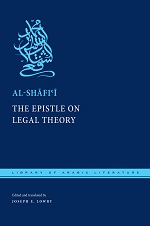Joseph Lowry, Associate Professor of Arabic and Islamic Studies in the Department of Near Eastern Languages and Civilizations at the University of Pennsylvania, is one of the world’s leading experts on al-Shāfi‘ī (b. 150/767 – d. 204/820) , author of The Epistle on Legal Theory (the Risālah) and widely considered the founder of Islamic jurisprudence.
Lowry, who was formerly a practicing attorney in Washington, D.C., spoke with M. Lynx Qualey over Skype about the ordinariness of Islamic law, the various things “sharia” has meant to an English-reading public, and why “Islamic law is this wonderful thing that, if jurists only knew about it, would amaze them.”
Marcia Lynx Qualey: How do you think your new translation of al-Shāfi‘ī’s Epistle, a ninth-century text, fits into a twenty-first century debate on the place of “sharia” law in US courts?
Joseph Lowry: For a variety of reasons, Islamic law is something that has wandered into the popular consciousness. It’s something many people seem to have heard of, and about which people have various ideas. Most of them, not surprisingly, are inaccurate. But some of these mistaken impressions of Islamic law are impressions that are understandable based on the world we live in.
So maybe what I should say is this: There’s a long tradition of highly technical and also intellectually very interesting legal thought in Islamic intellectual culture and in Islamic religious writing. Generally speaking, that tradition, for somebody who is trained in the law, would look very familiar: the ways in which Muslim jurists in the pre-modern period conceptualize problems, the ways in which they conceptualize and devise solutions to those problems, the ways in which they think about the world, and about classic legal problems like intent or contract formation, or criminal liability. These are all things that are all just very familiar to anybody with legal training.
I think generally when we hear [about Islamic law] in public life, we tend to hear about things like severe punishments for certain crimes, or the legal disabilities of women, or the legal disabilities of religious minorities under religious rule. So actually those things are also there, to some extent, but they are things that are really a fairly minor, indeed a statistically very insignificant part of the Islamic legal tradition.
[Another aspect] that might also be of interest or surprising to people today is the fact that the overwhelming character of Islamic criminal jurisprudence—that is, the doctrinal positions that jurists stake out in regards to criminal law—is exculpatory, which means that the overwhelming tendency is to try to find ways not to convict people.
I think that in the world in which we live, given the ways in which people tend to talk about Islamic law in public, they would be surprised at what a sort of unexceptional and normal legal system it is from the point of view of somebody with training in the law. And they would also be surprised, I think, at the intellectual sophistication and delicacy of Islamic legal theory.
If you were going to give a talk about this book to lawyers, what would you emphasize to them?
What do lawyers do when we read case law? If you’re a junior associate in a big law firm, as I once was, and you’re told to go research an issue, you go dig up a bunch of cases and you read them. There are various ways of finding out which cases are relevant to the particular issue you’re looking for.
So when you read these cases, inevitably, they are not all the same. And in fact some of them might look squarely contradictory. Your job then is to write a memorandum in which you explain what the field is of this particular legal issue as it’s expressed in the jurisprudence and judicial decisions. And the kinds of things you might do are explain why two cases differ. You might say, “Well, this judge’s decision looks like it’s different from this other judge’s decision, but really when you consider this factor and that factor, actually they have the same idea about what the law is. And there were some circumstances which caused this judge to decide the case differently, or interpret the statute differently as it applied to these facts.”
So you go through and look for things that help you group cases into groups of similar decisions and groups of dissimilar decisions. And that process of deciding what things are similar and what things are dissimilar, and what things look—and this is crucial—what things look dissimilar, but are in fact similar, is very much like what al-Shāfi‘ī does in the Risālah. There, he goes through and he looks at these passages in the Qur’an and looks at these pronouncements from the Prophet, and he says sometimes, “Well, yes, these look different but actually if you take into account this factor and that factor and the particular facts of the situation that Muhammad was addressing, or that was being addressed by the Qur’an, you’ll see that actually the underlying rule was the same.”
Or he might sometimes admit that there’s a difference and say, “Well, there’s a difference between these two rules, and they are really different, because one was revealed at one point in time, and another was revealed at another point in time, and the one that was revealed later superseded the one that was revealed before.” So that process of lining up expressions of legal rules into groups—that’s pretty much the task that Shāfi‘ī was undertaking. And that’s just basic interpretation of case law. It’s a way of reasoning that anybody who went to law school will immediately recognize as familiar.
What else would you say to a general audience interested in “sharia” law?
One of the ways that people become aware of Islamic law in the modern world is through the things that Muslims say in regard to the desirability of having Islamic government. I think when people talk in those terms in Islamic societies today, we need to remember that Islamic law becomes a political symbol. Since those pro-Islamic law discourses are implicitly and sometimes explicitly directed against what are perceived as the anti-Islamic policies of Western governments, including the United States, that one has to remember that the invocation of Islamic law’s rules—of criminal law, or rules affecting women—often get emphasized in the modern world in ways that are shrill and politically driven and that do not necessarily reflect the general prevalent trends of Islamic law in the pre-modern world. So in that regard, although they are politically understandable, they are ahistorical, for instance the imposition of severe criminal penalties in the context of calls for Islamic governance or an Islamic state.
I alluded to this earlier when I talked about the fact that Islamic criminal jurisprudence is mostly about exceptions, and it’s actually very hard to get convicted of most crimes under Islamic law. But the modern political invocations of Islamic law, coming as they do in the context of difficult relations with the West in some Muslim countries, give a particular emphasis to these aspects of Islamic law as culturally distinctive, and probably emphasize them more than they would’ve been emphasized by an author like Shāfi‘ī.
What brought you to this text?
The reason I wrote on this text, the reason I did my PhD thesis on this text, was that pretty much everybody – Western scholars and pre-modern Muslim scholars and modern Muslim scholars – consider that al-Shāfi‘ī’s Risālah is the first comprehensive treatment of Islamic legal theory and all its various sub-issues. So after this text, it’s really a good century and a half or more before we have any preserved texts that deal with the field of Islamic legal theory in a comprehensive way, in the way that the Risālah did, so really not until the late 10th century.
So one question, for somebody who is interested the history of Islamic legal thought is, what happened in between the time the author of this text died in the year 820 and say the year 1000, when you begin to get a relatively regular stream of such texts? So I originally set out to write about that gap. But the literary evidence is difficult, and in some cases non-existent.
When I began to look at the Risālah, I came to the conclusion that the field had not really understood it. And most of the things that the field had said about it were not just too general, but really often inaccurate, and it seemed to me that the point of the work had largely been missed by scholars. So I thought, well, maybe instead of working out what happened between Point A and Point B, maybe I should start trying to understand point A better than it had been understood.
Previous Western scholars had boiled the text down to this idea that it was a hierarchy of “four sources”?
Right, I think that’s generally the view that people had taken, that Shāfi‘ī was the first one to arrange, in a defined hierarchy, the so-called “four sources” of Islamic law, which are first of all the Qur’an, and the second the traditions from the prophet Muhammad, third the consensus of the community, and fourth, analogical reasoning, or legal interpretation.
So there are phrases that could give one to understand that that’s what al-Shāfi‘ī had in mind, but it’s certainly not the heart of this text. For one thing, that explanation doesn’t really deal with the main thing that happens in the text, which is the harmonization of conflicting rules expressed in revelation. Really, what the text does is provide a sort of arsenal or a toolbox for the jurist to use to sort through texts that are revealed that look like they express conflicting rules.
The text has already been translated. Why re-translate? The previous translators’ flawed understanding of the book?
I do think it is the case that the previous translators really did not believe the whole book added up to something beyond this idea of “four sources” [for Islamic laws]. But to take that position, you would really have to ignore a lot of the text, probably the majority of it. So I really felt strongly, after poring over the text numerous times, and taking copious notes, that the whole text was actually integrally organized to make one main point, which is that texts from revelation, although they may sometimes look as though they contradict each other, never do, if you know how to understand them properly.
So this caused me really to understand the text quite differently from previous translators. There is, for example, the English translation that’s been around for 52 years now, it appeared in 1961, by Majid Khaddouri, somebody who rendered great service to the field. I think there’s a sense in which the text is fairly atomistic in his rendering, which is to say that it’s a collection of discrete but not obviously connected recitations of legal rules and objections to the formulations of those legal rules and replies to those objections. Or to put it somewhat differently, I think that if a non-specialist were to pick up Khaddouri’s text and read through it, they would not really have much of an idea what the book was about. So in that sense I do feel that my translation presents a different book than has been presented previously.
How did you deal with the poetry as different from the prose?
There’s not much poetry in the Risālah, I think there’s four or five lines, and one of them is repeated later in the text, and they’re all there to illustrate the meaning of a particular adverb. Islamic law is this wonderful thing— if jurists only knew about it, they would be amazed by it and think it was incredibly interesting. Arabic poetry is also such a thing, where if people really knew about what Arabic poetry was like, and it’s a vast corpus of poetry, reaching from pre-Islamic times right down to the modern era, [they’d see that] Arabic poetry’s a fabulous thing, it deserves to be translated beautifully.
Has the Islamic legal tradition resisted translation much like Arabic poetry?
On the one hand, one doesn’t always have time to produce translations. Then it’s a relatively small field of people working in Islamic law. So the capacity of the field to produce translations is not that great. Then, the translations that do get produced—and I think this is true elsewhere in Islamic studies—tend to be translations by specialists for specialists, and this often leads to them being written in a kind of code that allows specialist readers to re-imagine the underlying Arabic, which is not, I think, probably the best way to translate. When you translate specialized literature, you do confront this problem of technical terminology that you do have to render in a way that’s consistent and productive, because otherwise you take a text that’s systematic and turn it into something that’s flabby and disorganized.
There are some sort of natural barriers in the constellation of the field of Islamic studies to getting more translations out there, which are really aimed at an educated readership that are not necessarily specialist readers.
Has the Western interpretation of the Risālah shifted?
In the West, people began to study the Risālah seriously around the year 1900, when it was first printed in Egypt in the old Bulaq Press in Cairo.
So the West has known about the Risālah for quite some time. There was a Dutch dissertation on it that was published as a book in the ‘30s, in which the author did realize that this harmonization issue was important. But generally the idea has been that the four sources theory was predominant. I think that was really solidified by the work of a scholar named Joseph Schacht. It’s just a really well-entrenched idea, this four-sources idea.
New interpretations take a while to percolate. I think people are maybe aware that I have a different idea, and I worked pretty hard for a few years to publicize this idea, in articles and lectures and in my book, and I’d like to think that it’s slowly seeping into the academic consciousness. I hope so.
And Arabic scholarly interpretations?
The question is what did the ancient authors say about al-Shāfi‘ī, because he was a very famous jurist, and there was a whole school of legal thought named after him. But they tend not to offer a holistic interpretation of the text. One thing they do say, and this is echoed in modern Arabic scholarship, is that Shāfi‘ī is the first person to systematically write down the principles of Islamic legal theory. But then after people say that—what it is that’s systematic about those principles is not really explained. I’d like to think that I’ve explained what’s systematic about them.
**************************************************


